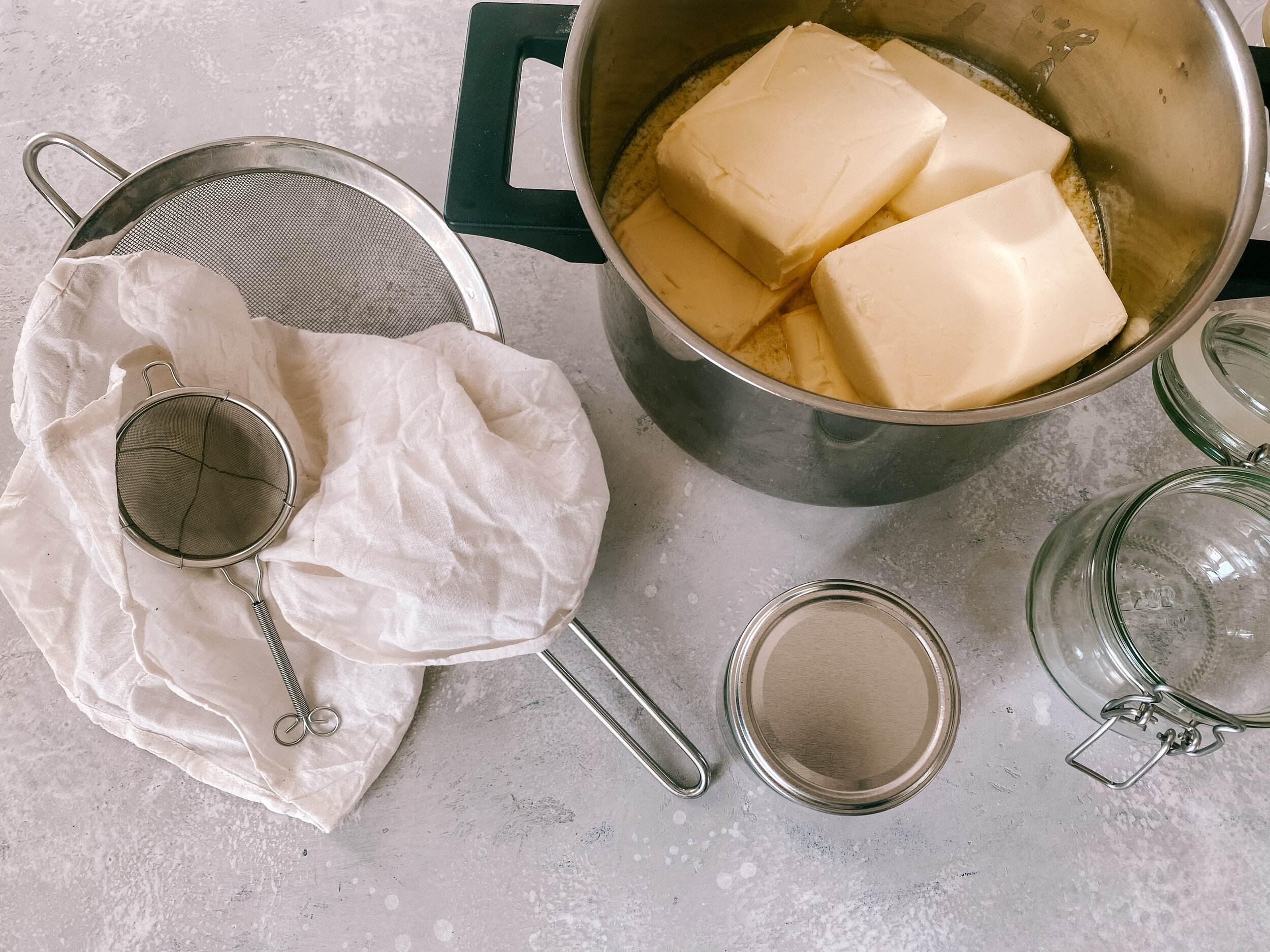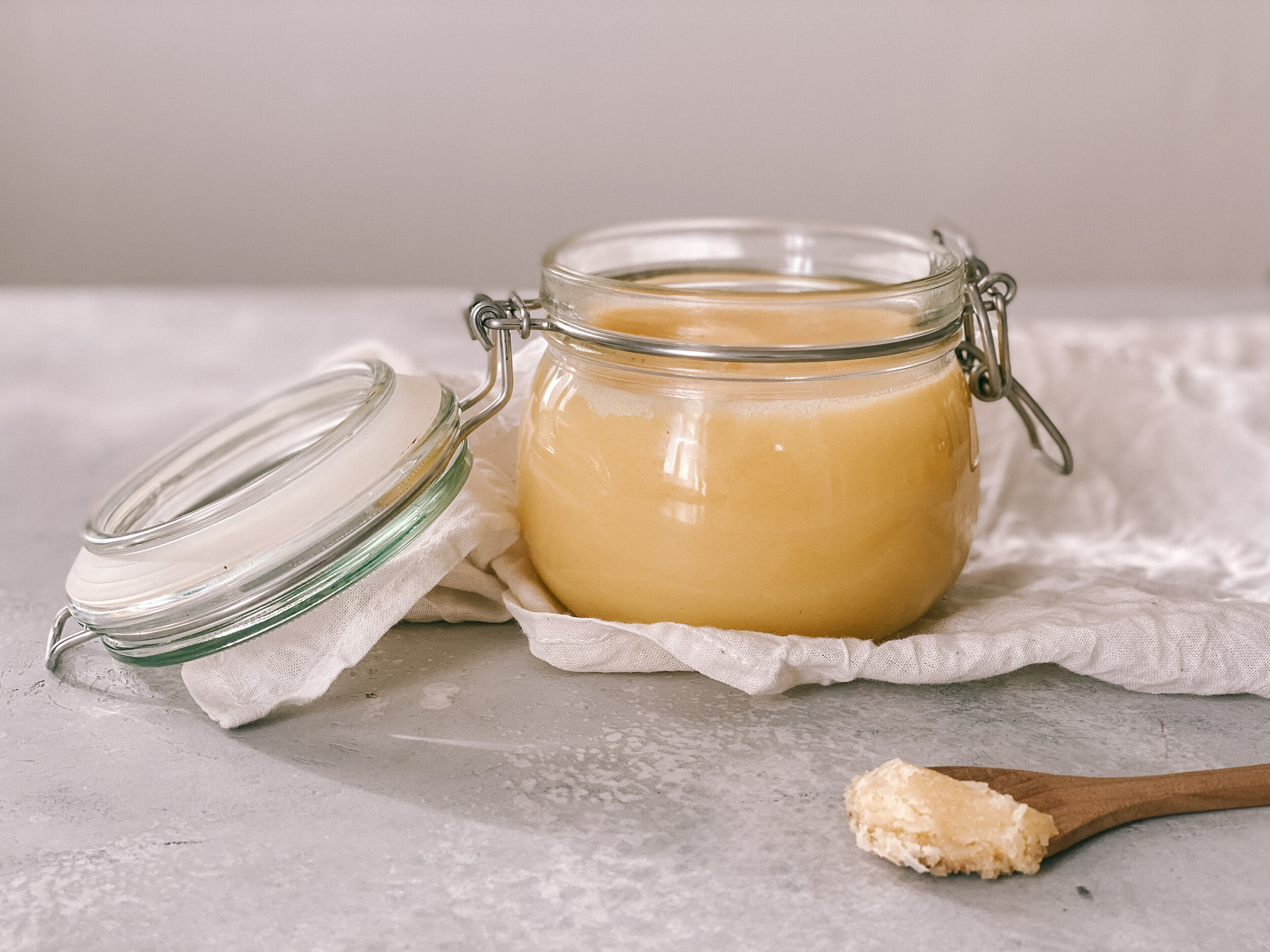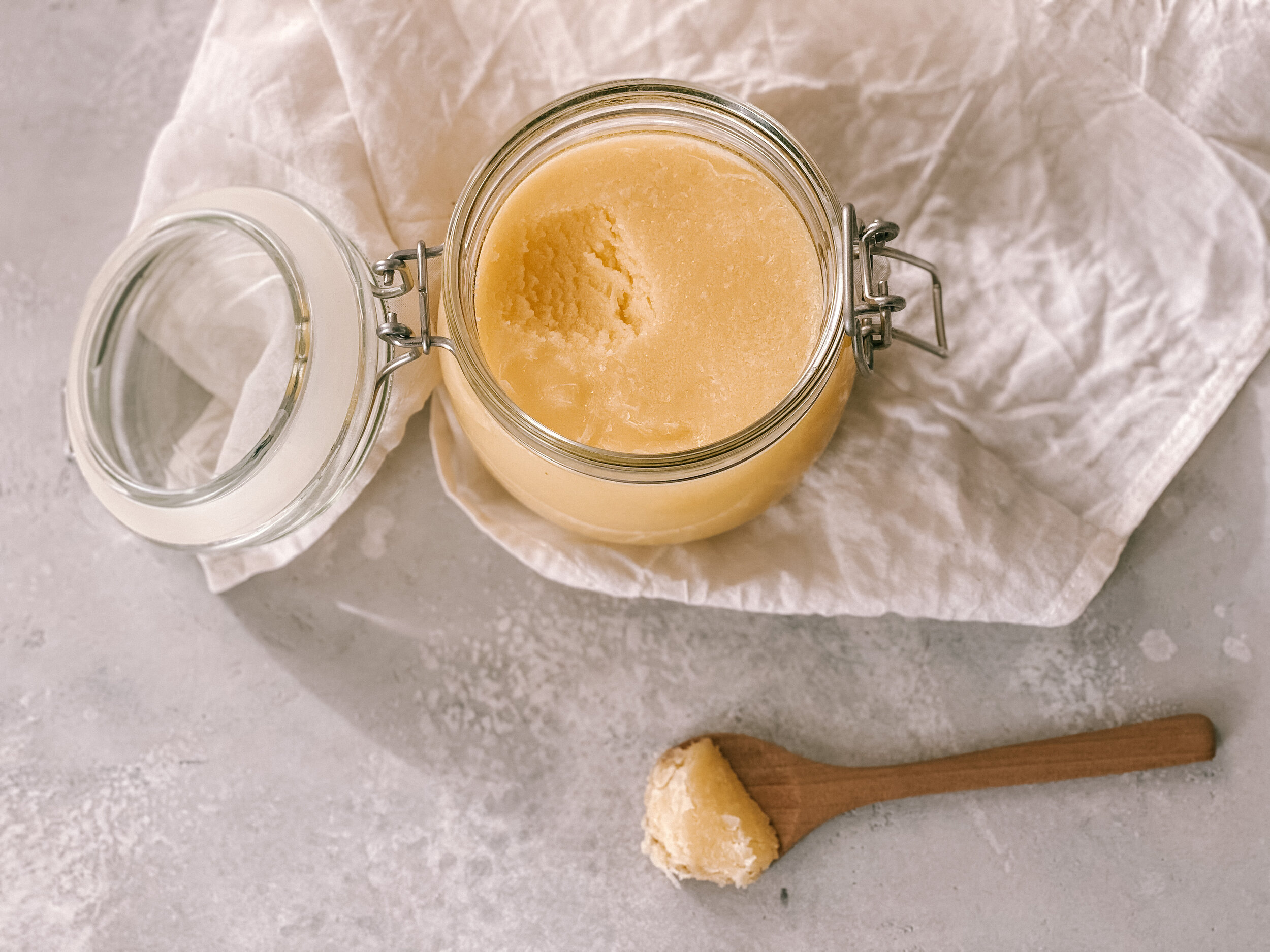Ghee
Ayurveda recommends Ghee since thousands of years, already The Rig Veda (1.3.26.7) considered it a “food of the Gods”. Ghee is an ancient sattvic food that helps to carry nutrients from our food much deeper into our tissues, unlike other fats. Because of this effect, it is commonly used in medicinal Ayurvedic treatments.
Ghee is a sattvic food, meaning it enhances the life force in the body harmonically, creating balance and it is a well-known Rasayana – a natural rejuvenator. It can get rid of decade-old slug and heavy metal deposits in the body, making it an important component in Panchakarma. An ancient Ayurvedic way of cleansing the cells, through five different therapies.
Ghee balances all three doshas (also called tridoshic). Although people with excess Kapha should use smaller amounts.
You may often hear that ghee is clarified butter but it is not entirely true. We cook it a little bit longer, during the process the cholesterol-forming milk solids, lactose and casein - which are hard to digest - are completely eliminated. This makes ghee ideal for anyone with milk intolerances.
Ghee is cancer-fighting because it contains CLA (conjugated linoleic acid). CLA is also well-known for its ability to aid the body in burning fat. Studies show that cows that are able to graze in grass pastures without supplemental feed had 500% more conjugated linoleic acid (CLA) in their milk, compared to cows with a typical diet.
When cows are grass-fed and pasture-raised, their milk contains one of the highest sources of CLA in the world. Some of CLA’s health benefits: immunity, healthy liver function, healthy bone mass, glucose metabolism, optimal weight, cardiovascular health, antioxidant activity.
Butter has its name from a fatty acid called butyric acid, in ghee this acid is concentrated.
Butyric acid is fueling cells of the colon, feeds good microbes in our bodies and boosts immunity. In fact, our gut loves ghee or the butyric acid so much that the microbes in our intestinal tract start making their own butyric acid. This microbe is called clostridium butyricum. People with an unhealthy digestion have less butyric acid production in the gut.
Benefits of butyric acid production in our own bodies are following:
· helps digestion
· maintains the integrity of gastrointestinal mucosa
· blocks bad + toxic bacteria in the gut
· helps the growth of bifidobacteria as well as other beneficial ones
· regulates normal bowel movements
· aids water + electrolyte concentration of the intestinal tract
· enhances insulin sensitivity
· supports healthy cholesterol levels
· increases the efficiency of energy + energy production
· diminishes fatty tissue
· decreases feelings of hunger
· strengthens killer T cell activity + boosts thermogenesis.
Many toxins from the environment, such as pesticides, preservatives, industrial toxins and heavy metals are fat-soluble. These toxins have been associated with hormone imbalances, lowered immune system, reproductive issues, cancer as well as other diseases.
Ghee is incorporated in Ayurveda, to pull these fat-soluble toxins from the body.
A ghee-based detox aids with detoxifying stored fat-soluble toxins, flushing gall bladder and liver, strengthening the ability to burn fat as a primary fuel, repopulating the gut with butyric acid, resetting the body’s upper digestive strength, supporting healthy lymphatic flow and restoring healthy intestinal tract lining.
Furthermore, ghee is good for the heart because it contains omega 3 & 9, it’s anti-inflammatory, good for digestion and helps you to lose weight.
It has a high smoke point up until 200 degrees Celsius, therefore you can use it in your cooking instead of butter. Ghee is perfect in your kitchen as it only burns when heated excessively. Its rich taste is similar to butter but more neutral than other oils.
Ghee will enhance the bioavailability of spices in your body – this means that your body can more easily make use of the healing properties of spices and food in general. Furthermore, it will make it easier for your body to digest food and you will need less amounts of ghee when you cook with it than butter.
Ghee contains many minerals and vitamins, such as natrium, kalium, calcium, phosphor, magnesium, iron, vitamins A, D, E K2 and niacin.
BENEFITS OF GHEE
free from lactose
free from salt
strengthens liver
aids digestion
slightly cooling, not heating like other oils
enhances brain capacity + memory
soothes nerves
helps with constipation
lowers cholesterol levels
anti-inflammatory
rich in vitamins + minerals
enhanced absorption of vitamins and minerals (as it has a similar structure of the lipid membranes of our cells)
cell regenerative
binds slag and diverts it
anti-aging
strengthens the immune system
increases sight
builds ojas
helps with anemia
aids with fever
good for the heart (omega 3)
also useable for skin diseases or burns
aids wound healing
helps against cough
used as nose drops it aids headache
strengthens eyes, nose + skin
lubricates intestinal tract (just like our own gut microbes called clostridium butyricum which are producing butyric acid, ghee is the highest known food source of this beneficial fatty acid which lubricates our intestinal tract)
enhances the digestive fire (agni)
pacifies all three doshas, especially Vata + Pitta
increases stamina
enhances longevity
cancer-fighting (with CLA)
lubricates joints
cleanses and nurtures blood tissue
detoxifying
aids hyper-acidic related digestive disorders
improves (fat) metabolism
stable cooking agent
an anupana, a carrier substance for medicine and spices
tridoshic, good for all doshas in moderation
it’s a rasayana (rejuvenating)
aphrodisiac
helps with fertility and supports the reproductive system of women and men
Making your own ghee will:
taste much better,
contain the love you put in and
be less expensive.
However, if you are not convinced and like to stick to a vegan diet – which is fully understandable – I would recommend using coconut oil instead of ghee. It works well in any recipe, although the taste will slightly differ. It also has very different properties and can’t penetrate all bodily tissues as deeply as ghee.
If you are open to trying something new, I highly recommend testing ghee for a while, to see its effect on your body as well as your mind.
AHIMSA (non-injury, non-harm)
I usually make my ghee from 4-8 packages of organic, biodynamic “ahimsa” butter. Choosing the right butter is essential. Needless to say, that cows must be treated with respect, love and care – ahimsa! When sourcing biodynamic butter from small farms, the cows are receiving nutritious food, have access to go outside and still have their horns.
The cows’ horns are essential to their metabolism. You will notice, when a cow digests, the horns become warm. The temperature of the horns changes and it helps to filter out negative side products from a cows’ digestive system. Hence, these by-products are not in the cows’ milk and not in the butter, nor in our ghee.
We do not want to consume dairy from cows who are mistreated, like a subject, harmed, just to be milked or slaughtered. We do not want such harmful energy in our food, ever! Remember, everything is energy. If an animal is harmed, the stress hormones land on our plate. That is why we practice ahimsa in Ayurveda, we treat ourselves and others in a loving way.
In Austria, biodynamic and organic butter can be found from Demeter or small producers, usually families such as Pötzelsberger, Strasser or Marksteiner. If you are in a country where you can’t find biodynamic butter, try organic, cultured butter from grass-fed cows and create awareness in your community about this topic, maybe you are able to convince a farmer!
FULL MOON RITUAL
In the Vedas, it is said that the best time to make ghee is during waxing moon, but especially on a full moon. The moon represents soma and its expansive energy will then be infused into the ghee, making it even more nourishing.
Chanting mantras in a loving way, when preparing the ghee will further enhance its nourishing qualities. Preparing ghee like this, on a full or waxing moon, is a ritual, meaning we honour the fullness of the moon and the fullness in our own lives. As the energies of plants and life itself will be enhanced during this time, so will the ritual of making ghee be more powerful than during other moons.
Please skip making ghee, when there is an eclipse, then it is rather a time to go inward. You should make ghee earliest three days before or after an eclipse, to not infuse it with darker energies.
Before I start making the ghee, which is a very sattvic (balancing, harmonious, peaceful) practice, I like to set my energy. I slowly and deeply breathe in and out at least three times. If I notice my mind not being present and drifting off, I will chant the Ganesh mantra. Generally, I chant the Mahamrityunjaya or Gayatri Mantra to fill the ghee with their healing qualities. I do everything with full presence, focus, and a whole lot of love – to not only ensure that it won’t burn but to infuse it with love and pure energy. By doing so, it is a full moon ritual.
Find below what you will need.
INGREDIENTS
- 4-8 packages of organic, biodynamic butter
- big pot + working stove
- finely meshed sieve or sieve with kitchen paper/milk cloth
- sterilized glass jars (read below how)
INSTRUCTIONS
For 500 g butter, you will approximately receive 380 g of ghee.
Before you start, you can check out my instagram reel, to see what the ghee making process looks like.
Take as much organic, biodynamic butter as you like and warm it up in a pot on middle heat. You will hear bubbling and butter foam will start to come to the surface. This foam is the lactose of the milk and can be put away and tossed or you simply leave it, as it will sink down. Make sure you do not overheat the butter. If you think it will, you may put the pot aside for one minute to let it rest until you heat it again. You can always check the temperature, and it should not be above 108 degrees Celsius.
Leave the butter cooking on the smallest flame. In the end, the ghee will be so golden, that you can see the bottom of your pot and the milk solids on the bottom.
This process may take 20-30 minutes, sometimes even longer, depending on the quality of the butter, what the cow ate, as well as the climate and altitude you are living in etc. please always watch the pot.
To test, whether the ghee is ready or not, you can use a match: Cut the ignition head off, light the match and dip the match into the surface of the gee in the pot. When it burns calmly, without hissing, the ghee is ready. Or you can let a drop of water fall into the pot and when it makes a crackling sound, it is definitely ready!
If the ghee is still very hot, let it sit for a few minutes.
Use only sterilized glass containers.
How to sterilize glass jars: Heat them for 15min in the oven at 180°deg Celsius or sterilize them with boiling water and make sure they are dry. Put the glasses in a bowl to be safe, if the glasses are thin and the temperature difference is too high, there is a possibility that they might break.
Put either a super finely meshed sieve or any sieve over the glass jar and a kitchen paper or milk cloth above, to filter out all of the milk foam that you might pour with the ghee into the glass. From my own experience speaking, a sieve and a paper towel make less of a mess.
Let the ghee cool down before you close the jars. Simply put a kitchen cloth over the opened jars, as ghee attracts every tiny particle that is in the air.
Wait until it has reached room temperature before closing the lid. I usually let them sit overnight.
Store the ghee in a dark place, not the fridge. After it has cooled down, your ghee will not stay liquid, it will slightly harden. There will only be mold, if there is a droplet of water inside or your serving spoons are not clean. Your ghee can last up to months, even years. Medicinal ghee can be decades, even centuries old. It is said that the older the ghee, the more medicinal it becomes – it is said that it can heal almost anything. I usually use my ghee quite fast and have to reproduce it every month.
Ghee can also be used in candles instead of wax. It is starting to turn liquid at 20 degrees Celsius and its healing properties are then released into the atmosphere, creating a special environment during meditation and prayer.
If I have inspired you to make and use ghee in your meals, tag me to let me know. I love sharing your food love with others!
Much love,
Lisa







